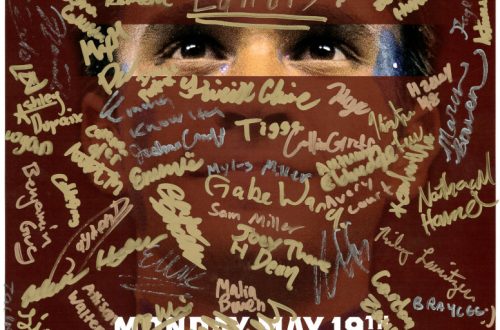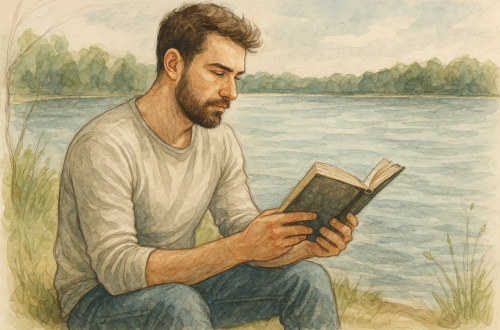I know the educational reasons for having music programs — and drama and sports and other such programs in schools. At least I know most of them. I know that these efforts, seriously engaged in, develop the mind, the heart, the body, the character — the person. I know they are a laboratory, in which youth can explore excellence in a relatively safe, supervised environment. I wrote about that once, in a season when the human cost of such efforts had become heroically, tragically high, and it was natural to wonder if it was worth it.
It is worth it. The reasons make sense to me, and I see them in action in my children, just as I see them retrospectively in myself, playing in the high school band from eighth grade, playing on the basketball team, and singing for two years in a fine ensemble we called the Snake River High School Chamber Singers.

All of this justifies the cost of instruments, private lessons, and band fees — even all the oh-dark-thirty driving between home and school.
All of this makes me willing to bear the cost.
Why I am glad to bear the cost is easy to remember and easy to see. I saw and remembered it tonight. It is more difficult to describe, but that is my object here.
I’m usually just barely in time for the Band Bash, an annual fall event held in the American Fork High School gymnasium. Each junior high and high school band plays one piece. That’s seven bands, if you’re counting. The stands are so full of family members that I sometimes don’t get a seat, but that’s okay. Tonight I was early and lucky, and I sat in the second row of the bleachers, maybe twelve feet from my son Joel, a horn player in the high school’s top band, the Wind Symphony. I was about the same distance from the conductor’s podium. This proximity didn’t change what I saw and heard; it just made it more obvious.

I sat for twenty minutes or so before the Bash began, chatting with some friends who passed by or sat nearby, and watching as my son and his peers trickled in and took their seats.
I know many of these youth from helping to make a movie about them recently. I’ve listened to them talk about their experiences, and I’ve heard them laugh and seen them cry. I interviewed dozens of them, and they were candid, personal, and delightful. I’ve witnessed sophisticated hijinks — some smart and calculated, and some just youthful and crazy — which even parents must appreciate, if the parents have the good fortune never to have finished growing up.
But tonight these youth are in black concert attire, floor-length gowns and tuxes and bow ties. There is some friendly chatter and light-hearted humor among them as they find their seats before the concert, but I can tell they’re here to play, not to play around.
They are relaxed but quiet and mostly serious, waiting for their turn, listening as the four junior high and two high school bands before them play very well — each better than the last, because it all starts with a surprisingly good beginning band and works up from there. Among the Wind Symphony there’s an occasional quiet smile or small wave at a friend across the band, or in another band, or at a family member or teacher. Now and then I see (but never hear) a discrete whispered word.
There are six bands seated on the gym floor and one waiting together in the bleachers across the way. Only one plays at a time. The evident respect for peers in all the students’ behavior is impressive.
With one exception, each band is led by someone I’ve come to know over the years — and more to the point, someone I have learned to respect as a fine person and gifted teacher. (Both of these matter, because we study our teachers as much as we study our subjects.) The exception is a student teacher I’ve met only briefly, but who seems excellent and personable — and who must be someone special to fit into this crowd, even as an apprentice.
Each band’s woodwinds, brass, and percussion raise the bar for the next band. Before we get to the high school Wind Symphony, I realize that we’ve already moved beyond students just playing instruments. They’re playing music.
One of the high school bands is playing. The brass are solemn now, almost mournful, then suddenly resplendent. The woodwinds are plaintive, then exuberant, running up and down and all around together — so together, yet with delightful abandon. It’s a light-hearted dance, but with Slavic undertones; then the undertones come powerfully to life in the music and the listeners, and for a few moments we all are . . . Russian?
The music is relaxed, then frenzied; harmonious, then dissonant; light and gentle, then sonorous. The percussionists are doing things the kids in my high school band had never seen high school percussionists do, on instruments my school didn’t even own.

Finally it’s time for the high school Wind Symphony, the last and best of the bands. Year after year, it is better than the Idaho All-State Band in which I played trumpet in 1982. John Miller, the elder statesman and grand master of Utah high school bands, stands next to the podium. The students sit straight, at the front of their chairs. One nudges a music stand slightly; another adjusts a reed — a double reed, because I often watch the oboes, a habit born of loving to listen to the oboes.
Even their tuning notes sound great.
Mr. Miller takes the podium. The band is silent, rapt, a motionless mass of potential energy. They’re not so much kids as musicians now. This is business — the business of joy and a dozen other passions, perhaps, but still business. It begins.
When they play, their rhythms and chords are more complex and precise than the other bands’. We expect this; it is the Wind Symphony. Their entrances and cutoffs are cleaner, and their intonation is excellent. As fine as the earlier bands were, everything with this one is more artful, more precise, more together. Their piece tonight, which I don’t know and didn’t hear announced, is alternately jubilant and sedate. Was that a cowbell?
And the tympanies . . . How did humanity ever live without tympanies? The power, the energy, the implacable rhythm . . .

This is the band I always wanted to be in — and thought I was in, once or twice. But we were never this good.
Complete concentration. Irresistible energy. Discipline and unity. Power. Beauty.
A grand, final chord, and it’s over too soon. My heart might be devastated, if my head were not certain that the marching band is next. They’ll clear the chairs and stands from the floor, set up the front ensemble — the pit, we sometimes call them, but I’m not sure they all like that term. The state’s best marching band will perform tonight without the infusion of beauty, grace, and energy that is the color guard. They’ll be in concert attire instead of their red, white, and black uniforms (and this year, their garish and delightful Bad Hair). And they won’t be doing their drill.
They’ll stand in their arc — a semicircle that fills the gym floor — and play their show music. And when they’re done, we’ll give them the standing ovation they deserve.
Here’s another way of seeing it: members of, I think, four or five of the concert bands which have already played will form a single, massive, relentlessly rehearsed, seasoned ensemble. They will play ten minutes of music they have worked for half a year to perfect.
It begins gently, with Edvard Grieg’s “Morning Moods” from Peer Gynt, some of the first classical music I ever loved. Soon the soft, lyrical, familiar melody becomes loud, energetic, and powerful — because this is a marching band. Then we visit The Barber of Seville, and then we “Kill the Wabbit.”
There’s the Grieg again, but this time, after a brief pastoral interlude, it explodes into jazz, featuring a gifted soloist doing reliably amazing things with a soprano saxophone.
Then there’s the Offenbach “Can-Can,” with some glorious, precise woodwind runs — a familiar melody, with a passing wish for high-stepping dancing girls.
Make no mistake; this is still a visual show, even without the splendor of the color guard, even without the intricate drill and the uniforms. I’m sitting right in front of the pit, er, front ensemble, which is a spectacle in itself. What they’re doing looks like a hybrid of dance and some martial art, but they’re also sounding an incalculable number of notes with blinding speed and mind-boggling precision. Their power, energy, showmanship, and unity are stunning in combination.
I used to prefer watching the band’s field show from high up in the stands, where the formations are more visible and coherent. But somehow, in making that movie I mentioned and watching a hundred hours of raw video footage over and over again, I came to prefer seeing the musicians at close range. Now it’s less about the music people make, and more about the people who make the music. So watching the percussionists in the front ensemble from my second-row seat is doubly a delight.
I don’t play any more. The best I can do is write sometimes about the people who do. But there is a purity in this musical experience. Where does it come from?
Does it come from the heart? The mind? The conductors and teachers? The composers? The students? (Only one is my own offspring, so it’s not simply a parental exaltation.) Does it issue from some divine fount of beauty and grace? From all of these, perhaps. I cannot separate the components.
This year, I’ve seen the field show half a dozen times or more, in rehearsals and performances, so I know when the end is coming. I do not welcome its arrival. A moment later, the splendor is but an echo. Another moment, and it is merely a memory. It’s glorious but sad — because it really is the end. The marching band show season ended last weekend. If I’m lucky, I’ll hear this band play this music one more time, at an upcoming event. After that, I’ll never hear it live again.
What I know, as I contemplate the grandeur, as I watch and listen to these fine, youthful musicians — all I really know is that this is good, and it is beautiful. And the title of the movie got it wrong.
Music of the Heart? No. Music Is the Heart.
Then, for a welcome moment, it’s not quite the end. After a fond ovation the band begins to disperse, but the drum line breaks into a sort of impromptu, energetic — forgive me — postlude, as drum lines often do.
And then it really is the end.
Until next year, at least, when — somehow — they’ll do it all again. Marching band, Band Bash, different but amazing music, all of it. I’ll feel the same next year. This is how I felt last year. And there will be some fine concerts in between.
This is not just why we do this, I think for the tenth time tonight. This is why we love to do this.



Joylin Lincoln says:
So beautifully written. The life of a parent of student musician is one of patience, hard work, crazy hours, little spare money, and pure pride. I wish I had known your family was part of the amazing American Fork Band – because we could have meet up, as I followed my own musicians through their season at Westlake. I have to secretly admit that the next few months are my favorite though as they begin to work on their concert season. My heart just sings when I see how far high school musicians have come.
David Rodeback says:
Not mentioning a lot of names in this post was a stylistic decision, but had I mentioned more, the first three would have been the teachers who conducted the bands at the Band Bash, other than John Miller, whom I did mention: Anne Boyer, who directs the elementary bands, helps with the AFJH bands, and has an impressive resume inside and outside of music education; Lance Major, Director of Bands at AFJH and a key member of a large marching band staff, who is as talented as you’d expect and nearly as young as he looks; and Court Mackie, the student teacher I mentioned, from Brigham Young University, of whom staff and students alike speak with superlatives.
Rita Macewicz says:
Having participated in music performance from childhood through adulthood, and as a parent who encouraged and supported involvement by my children, I am pleased to state that music lives on in the “hearts” of my adult children and their children. I’ve been delighted through the years that many have been participants in musical endeavors from elementary school through their respective universities. I might add that, through the wonders of Facebook, I have heard seen and heard grandsons recently performing in high school and college concerts as far away as Pennsylvania.
.